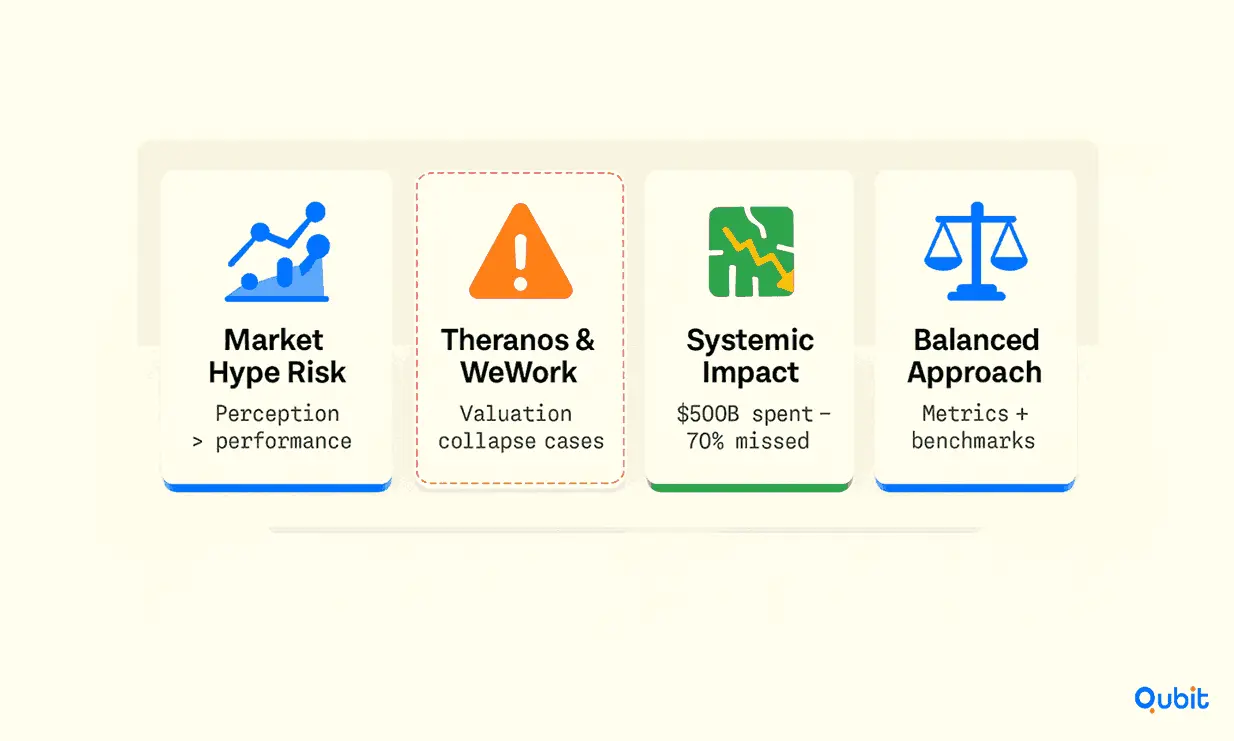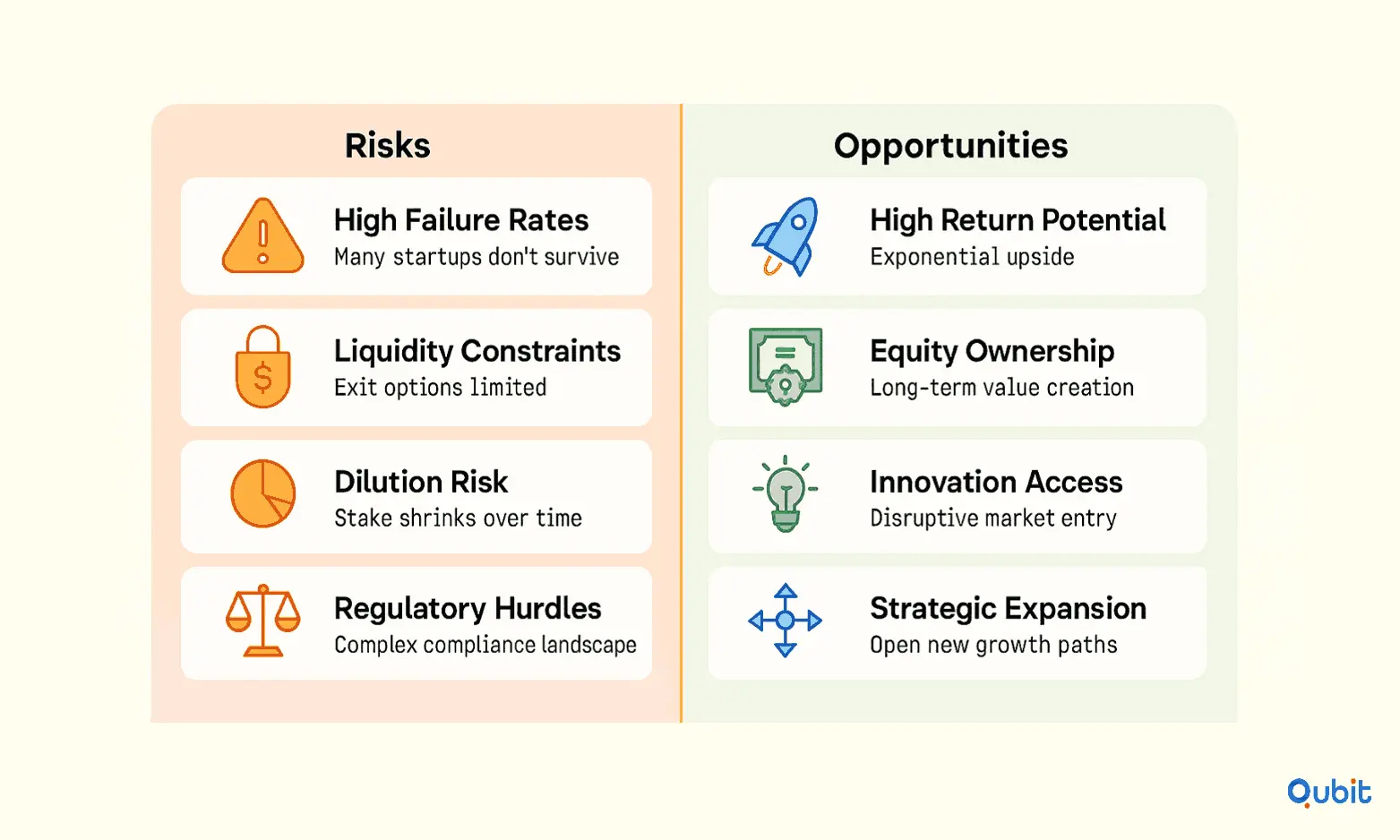Acquiring a startup can be an exciting opportunity, but it’s also a process fraught with risks, chief among them, overpaying. Overvaluation is a common pitfall, often stemming from emotional decision-making or incomplete due diligence. To make informed choices, it’s crucial to understand the factors that drive realistic valuations and how to assess them critically.
Your analysis benefits from startup acquisition strategies that broaden your perspective on market trends and deal dynamics within a comprehensive framework. This foundation can help you avoid costly mistakes and focus on acquisitions that align with your goals.
Let’s jump right in to explore how you can safeguard your investments and ensure you’re paying the right price for the right opportunity.
Understanding Overvaluation and Valuation Methods
Startups often find themselves in the spotlight, attracting significant investor attention. However, this enthusiasm can sometimes lead to inflated valuations, driven by market hype and unconventional metrics. While innovative valuation methods aim to capture the unique potential of startups, they often diverge from traditional financial models, creating risks for both founders and investors.

The Role of Market Hype and Nontraditional Metrics
Market hype can amplify a startup’s perceived value, especially when investors focus on growth potential rather than tangible financial performance. Nontraditional metrics, such as user engagement or projected market share, often overshadow industry benchmarks and sound financial models. This approach can result in valuations that are disconnected from the startup’s actual financial health, setting the stage for future corrections.
Case Studies: Theranos and WeWork
The cautionary tales of Theranos and WeWork highlight the dangers of overvaluation. Theranos, once valued at $9 billion, collapsed when its technology failed to deliver on promises, exposing the risks of relying on hype over substance. Similarly, WeWork’s valuation plummeted from $47 billion to $8 billion after its business model and governance issues came under scrutiny. These examples underscore the importance of realistic valuations grounded in industry benchmarks and proven financial metrics.
The Systemic Impact of Inflated Valuations
The broader market implications of inflated valuations are significant. For instance, during peak periods, investors collectively spent more than $500 billion, illustrating the prevalence of overvaluation. Additionally, 70% of founders reported that their final exit valuations fell short of earlier projections, signaling systemic issues in startup valuation practices.
Balancing Innovation with Financial Prudence
To avoid the pitfalls of overvaluation, startups and investors must strike a balance between innovative metrics and traditional valuation models. Incorporating industry benchmarks and sound financial metrics ensures a more realistic assessment of a startup’s value, reducing the likelihood of market corrections and founder disappointment.
Impact and Mitigation of Overvaluation
Overvaluation can significantly alter the dynamics between startups and investors, often leading to strained relationships and missed opportunities. When a company is valued beyond its realistic market worth, it creates inflated expectations that can be difficult to meet. This misalignment not only affects immediate funding outcomes but can also hinder long-term growth by discouraging future investment rounds.
The Role of Market Trends and Investor Sentiment
Market cycles and investor sentiment are pivotal in shaping valuation dynamics. During bullish market phases, optimism can drive valuations higher, sometimes beyond sustainable levels. Conversely, bearish trends may lead to undervaluation, creating a challenging environment for startups to secure funding. Investor sentiment, influenced by broader economic conditions and sector-specific trends, further amplifies these fluctuations. Understanding these external factors is essential for startups aiming to maintain realistic valuations.
Common Pitfalls of Overvaluation
Startups often fall into the trap of overvaluation by focusing solely on short-term gains. While an inflated valuation might attract initial attention, it can backfire during subsequent funding rounds if the company fails to meet growth expectations. This misstep can erode investor trust and damage the startup’s reputation in the market. Furthermore, overvaluation can complicate acquisition discussions, as potential buyers may hesitate to engage with a company priced above its actual worth. For a deeper understanding of how investors assess startups during critical phases, the detailed discussion on evaluating startups for acquisition during fundraising offers valuable insights.
Strategies to Mitigate Overvaluation Risks
Conduct Robust Due Diligence
A thorough evaluation of financial metrics, market position, and growth potential is crucial. Startups should collaborate with financial advisors to ensure their valuation aligns with industry benchmarks.Set Realistic Benchmarks
Establishing achievable milestones can help maintain credibility with investors. These benchmarks should reflect both current performance and realistic future projections.Monitor Market Trends
Staying informed about industry trends and economic indicators allows startups to adjust their valuation strategies accordingly. This proactive approach ensures alignment with market realities.Foster Transparent Communication
Openly discussing valuation methodologies with investors builds trust and demonstrates a commitment to sustainable growth. Transparency can also help manage expectations effectively.
By addressing overvaluation risks head-on, startups can position themselves for long-term success while maintaining strong investor relationships.
Due Diligence and Negotiation Strategies
Thorough preparation is the cornerstone of successful acquisitions. A comprehensive due diligence process ensures that every aspect of a potential deal is scrutinized, minimizing risks and maximizing opportunities. This section explores the critical components of due diligence and negotiation strategies, offering actionable insights for buyers aiming to secure favorable outcomes.
Key Elements of Due Diligence
Effective due diligence involves a multi-faceted approach to evaluate the target company’s financial health, legal compliance, and intellectual property (IP) assets.
- Financial Analysis: Assessing the company’s financial statements, revenue streams, and liabilities is essential to determine its true value. This step helps identify any hidden costs or risks that could impact profitability.
- Legal and Compliance Checks: Reviewing contracts, regulatory compliance, and potential legal disputes ensures that the acquisition aligns with applicable laws and avoids unforeseen liabilities.
- Intellectual Property Assessments: IP assets often hold significant value, especially for tech-driven businesses. Verifying ownership, patents, and trademarks protects against future disputes and enhances the company’s competitive edge.
Strategic Negotiation Tactics
Negotiation is where preparation meets execution. Employing strategic tactics can help buyers secure favorable terms while mitigating risks.
Set a Maximum Price Threshold
Establishing a clear maximum price ensures that emotional decision-making doesn’t lead to overpayment. This threshold should be based on thorough valuation analysis, factoring in market conditions and the company’s growth potential.Utilize Earnouts for Risk Mitigation
Earnouts tie a portion of the purchase price to the target company’s future performance milestones. This approach aligns the seller’s incentives with the buyer’s expectations, reducing the risk of overestimating the company’s value.Factor in Market Conditions and Investment Stage
The broader market environment and the company’s stage of development play a pivotal role in valuation accuracy. For instance, early-stage startups may require a different pricing strategy than mature businesses. A closer look at how fundraising affects startup acquisition potential illustrates the financial nuances that can subtly shift the value and attractiveness of an acquisition opportunity.
Balancing Risk and Opportunity
Combining rigorous due diligence with strategic negotiation tactics allows buyers to balance risk and opportunity effectively. By focusing on financial, legal, and IP evaluations, and employing tools like earnouts and price thresholds, buyers can make informed decisions that align with their long-term goals.
Synergies and Lessons from Past Acquisitions
Successful acquisitions often hinge on two critical factors: strategic alignment and cultural compatibility. When businesses share a unified vision and complementary cultures, the potential for long-term success increases exponentially. This section delves into key insights from past acquisitions, highlighting both triumphs and missteps to underscore the importance of strategic synergies.
One standout example of a successful acquisition is Disney’s purchase of Pixar. Beyond the financial benefits, this deal thrived due to the alignment of creative goals and a shared commitment to innovation. Both companies valued storytelling and creativity, which allowed them to integrate seamlessly and produce groundbreaking content. On the other hand, acquisitions like AOL’s merger with Time Warner serve as cautionary tales. Despite the initial promise, the lack of cultural synergy and overestimated strategic benefits led to significant losses.
Overpaying for acquisitions is another common pitfall. Companies that fail to conduct thorough due diligence or overestimate synergies often face challenges in recouping their investments. Learning from such cases can help businesses avoid similar mistakes. For instance, ensuring that financial projections are realistic and that cultural integration plans are robust can mitigate risks.
Well-executed synergies not only enhance operational efficiency but also drive long-term ROI. This is particularly evident in acquisitions where companies align their strengths to create new opportunities. Consider the exploration in structuring startup acquisition deals, which demystifies the negotiation elements and financial structuring that align with your strategy to avoid overpayment.
Ultimately, the lessons from past acquisitions emphasize the importance of aligning business goals and fostering cultural compatibility. By prioritizing these elements, companies can maximize the value of their deals and set the stage for sustained growth.
Investment Risks and Opportunities in Startup Acquisitions
Startup acquisitions present a dynamic mix of risks and opportunities for investors. While the potential for high returns is enticing, the challenges associated with these investments cannot be overlooked. Understanding these factors is essential for making informed decisions in this high-stakes arena.

Risks in Startup Acquisitions
The inherent risks of startup acquisitions stem from the volatile nature of early-stage businesses. According to Bureau of Labor Statistics data indicating high failure rates in new businesses, a significant portion of startups fail within their first few years. This underscores the importance of rigorous due diligence before committing to an acquisition.
Liquidity issues also pose a significant challenge. Unlike publicly traded companies, startups often lack the liquidity needed for investors to exit their positions easily. Additionally, ownership dilution can occur when startups raise additional funding rounds, reducing the stake of early investors. Regulatory hurdles further complicate the landscape, as compliance requirements can vary widely depending on the industry and jurisdiction.
Opportunities in Startup Acquisitions
Despite these risks, startup acquisitions offer unique opportunities that can make them highly rewarding. One of the most compelling advantages is the potential for high returns. Successful startups often experience exponential growth, providing early investors with substantial gains.
Equity ownership in a startup also offers long-term benefits. Beyond financial returns, it provides investors with a stake in innovative ventures that have the potential to disrupt industries. This innovation-driven growth can lead to significant market advantages and open doors to new opportunities.
Mitigating Risks Through Diversification and Strategy
To balance the scales between risk and reward, diversification is a critical strategy. A well-diversified portfolio can help minimize exposure to individual startup failures.
Additionally, utilizing financial tools and seeking expert advice can further mitigate risks. Investors can consult Financial advisor recommendations for managing startup investments to tailor strategies that align with their risk tolerance and financial goals.
Startup acquisitions are not without their challenges, but with the right approach, they can offer unparalleled opportunities for growth and innovation. By understanding the risks and leveraging strategic tools, investors can position themselves for success in this dynamic market.
Conclusion
Acquiring a startup is a multifaceted process that demands careful planning and execution. Throughout this blog, we’ve emphasized the importance of conducting thorough due diligence, setting realistic valuations, and approaching negotiations with a clear strategy. These elements are not just steps but critical pillars that ensure a successful acquisition journey.
A narrative-driven approach, supported by robust data, can significantly enhance decision-making. By focusing on the story behind the numbers, investors can identify opportunities that align with their goals and mitigate risks effectively.
If you're ready to elevate your acquisition strategy, we at Qubit Capital can help with our Startup Matchmaking service. Let’s connect and secure the best opportunities together.
Key Takeaways
- Realistic valuations and industry benchmarks are key to avoiding overpayment.
- Thorough due diligence across financial, legal, and IP aspects mitigates acquisition risks.
- Market trends and investor sentiment are critical in determining true startup value.
- Strategic alignment and cultural compatibility enhance long-term post-acquisition success.
- Diversification and advanced financial tools balance risk and maximize potential returns.
Frequently asked Questions
What is overvaluation risk in startup acquisitions?
Overvaluation risk refers to the danger of paying more than a startup’s true worth, often due to inflated metrics and market hype.






